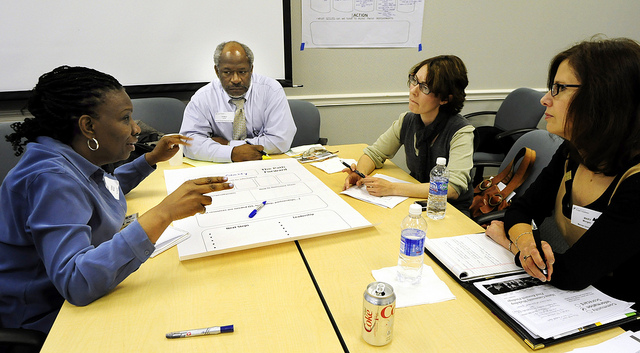Also in this series
Informing Communities: Sustaining Democracy in the Digital Age
The Report of the Knight Commission, 2009
Universal Broadband: Targeting Investments to Deliver Broadband Services to All Americans
Blair Levin, 2010
Rethinking Public Media: More Local, More Inclusive, More Interactive
Barbara Cochran, 2010
Digital Media Literacy: A Plan of Action
Renee Hobbs, 2010
Government Transparency: Six Strategies for More Open and Participatory Government
Jon Gant and Nicol Turner-Lee, 2011
Creating Local Online Hubs: Three Models for Action
Adam Thierer, 2011
Assessing Community Information Needs: A Practical Guide
Richard C. Harwood, 2011
At the heart of this paper sits a simple guiding principle: The key to building what the Knight Commission calls a community’s “healthy information environment” requires taking steps that are relevant and meaningful to the people who make that community home—that enable people to become informed, engage with one another, address the issues they care about and create the community they want. But not just any information will do.
Meeting this challenge will require a fundamental shift in how people’s information needs are approached. Simply replicating or aggregating existing ideas and tools, or instituting new programs and initiatives alone, will not necessarily produce new and useful knowledge for communities. Nor will merely adding to the wide array of RSS feeds, blogs, recommendation filters, online rating tools and social bookmarking sites.
In reality, most change in communities occurs through pockets of activity that emerge and take root over time. These pockets result from individuals, small groups, and various organizations seeing an opportunity for change and seizing it, often through trial and error. Seldom are the collection of such pockets orchestrated through a top-down, linear plan; instead, they happen when people and groups start to engage and interact. In this way, different groups at different times play a crucial catalytic and connecting role—helping to foster the conditions for people to tap their own potential and join together to forge a way forward.
The point for those seeking to gauge and grow a community’s information environment is not to see or create a single information destination, but to allow for many and varied touch-points for people who are stepping into and making their way through community and public life. It is important not to try and own the space, control the flow of information, or dictate change, but to generate multiple information sources in the community.
This paper is a practical guide for individuals and groups to assess and build a healthy community information environment. The paper lays out four important guideposts in moving forward:
1. Those seeking to assess and build a strong information environment must turn outward toward their community.
2. Progress in building a robust information environment will come best and fastest by using a specific issue to focus a community’s efforts.
3. Emphasis should be placed on how knowledge is generated in a community and on its quality and flow, not solely on counting and increasing the sources and volume of information.
4. Taking effective action requires innovation, not simply good planning.
Along with these guideposts are nine strategies for a community to assess and build a healthy information environment:
Strategy 1: Create an authentic steering committee
Strategy 2: Define “community”
Strategy 3: Engage the community early on
Strategy 4: Mobilize the community as a resource
Strategy 5: Create a discipline of making sense of what you are learning
Strategy 6: Make clear choices about what actions to take
Strategy 7: Actively cultivate boundary-spanning organizations and groups
Strategy 8: Tell the community’s story of change
Strategy 9: Ensure enough entry points for people to engage
The ideas and strategies in this paper can be used with any specific set of tools a community uses to assess and build its information environment, including the Community Information Toolkit created by the Knight Foundation and Monitor Group.
When reading this paper, it is important to remember that all across America people yearn to re-engage and reconnect with one another, to be part of something larger than themselves, and to make a difference in their own lives and the lives of others. But they often lack the vital information and practical means by which to come together to act on what matters most to them. The result is that many people and communities find themselves stymied or not moving fast enough to meet the pressing challenges before them—from public schools to public health to safe streets.
It is within this context that we must meet the information needs of communities.
